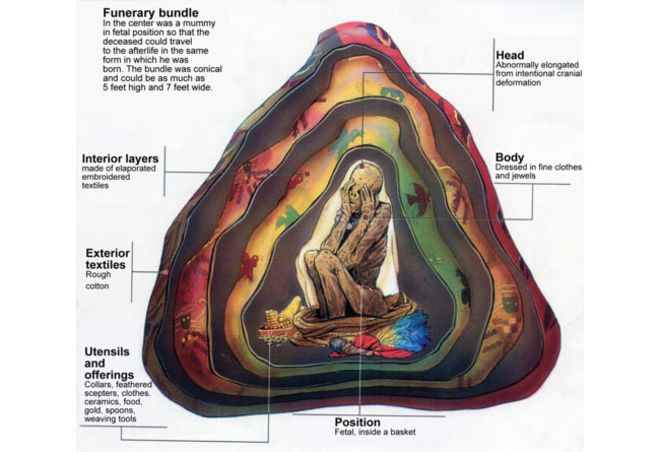For the spring 2017 course, “The Inca and Their Ancestors: Andean Objects, Technologies, and Issues of Conservation,” students have begun studying different aspects of the Paracas culture (B.C.E. 800-1 C.E.), one of the earliest known complex societies in South America. While each class throughout the semester will focus on a different society and technology of the Pre-Columbian Andes, the class research project is dedicated to Paracas society. More information on this project will be provided through future posts.

Paracas society, located on the south coast of Peru, is best known for its large cemeteries and funerary practices which included individuals and multiple individuals being wrapped in layers of textiles creating “mummy bundles”. The subtropical dessert environment in the Paracas Peninsulas also allowed for the most favorable conditions for mummification, preservation of spectacular textiles that were part of the mummy bundles.

In the Paracas Peninsula two distinct types of cemeteries have been found. The earliest example called Paracas Cavernas is characterized by compact internments in subterranean caverns with burials customarily conical in shape and wrapped in a coarse outer cloth sewn closed. Each person was wrapped and buried individually in an extended position, while caverns held both male and female adults, as well as children— a possible sign of familial groupings. Once placed in earthen pits, offerings were placed around or atop of the body. In the late Paracas era, stone architectural chambers with densely pact mummy bundles distinguished a new internment phenomenon. Labeled Paracas Necropolis, bodies were buried in a flexed position either alone or in multiples. In 1929, the Peruvian archeologist Julio C. Tello unearthed the Paracas Necropolis Wari Kayan, an important site that uncovered 429 mummy bundles, which were unique for the multiple layers of extraordinary woven textiles that enveloped both the body and the grave goods.
Paracas Necropolis first came to Tello’s attention when remarkable examples of never before seen woven and embroidered textiles began to circulate the open market and appear in private collections. In 1925, Tello had a looter guide him to the Paracas site, where with his team he excavated the remains of the immense burial grounds. The discovery received international attention and some of the mummies traveled as “ambassadors of good will” to museums for display or for scientific study. In the late 1930s during a trip to Peru, Tello introduced Nelson Rockefeller to ancient Andean textiles, as well as the mummy bundles he unearthed at Paracas. Impressed by Tello’s findings, Rockefeller supported his efforts to conserve and appropriately house the remains, which were kept in deteriorating conditions, and in turn Rockefeller was given four mummy bundles to take back to New York. The objective was to give the bundles to the Metropolitan Museum of Art, but due to the fact there was no one with the knowledge to care for them, the mummies were then given to the American Museum of Natural History.

About half of the Paracas Necropolis bundles excavated have been opened and their contents studied. The individuals include male and female elites with clear cranial deformations. The technique of cranial deformation consisted of placing two boards wrapped together at the front and back of the head to allow the infant’s skull to shape into a distinct elongated shape. The unwrapping of the mummies also found that the bodies were generally placed in a seated flexed position within a coiled basket or gourd and covered with layers of patterned textiles. In addition to elaborately decorated textiles, mummy bundles also included feathered costumes, gold jewelry, food and ceramic vessels. The mummy bundle chart provides a visual description for how the deceased and funerary offerings would have been wrapped within the layers of textiles.

Textiles were a central medium in which cosmological beliefs could be expressed meaningfully through iconography. Textiles also denoted a person’s status within the greater community and it is believed that mummy bundles with the most prestigious members of society had supremely opulent textiles that were immensely labor intensive to produce. Some burial cloths that spread over 1000 square feet, could have taken one weaver an estimated 30,000 hours (or three and half years) to create, however studies have suggested that the production of these works were often collaborative efforts. One extraordinary burial cloth is the mantle pictured here, which in 2014 was repatriated to Peru by the City of Gothenburg in Sweden. Measuring approximately 42 x 21 inches, the textile is made of squares with thirty-two unique figures that include animals, humans, plants and tools. Traditionally, embroideries from Paracas often portray the same imagery through patterned designs, yet archeologists have suggested that this mantle symbolized the movement of time, similar to an advent calendar. The color, size, and composition of this remarkable example speaks to the ingenuity and technological knowhow held by members of the Paracas society.
In the next class students will analyze Paracas ceramic vessels at the Metropolitan Museum of Art, which are distinctive for their double spouted bridge bottles, incised line designs, and the application of post fired paint.
Vreeland, James M. “Mummies of Peru.” In Mummies, Disease & Ancient Cultures, edited by Aida Cockburn, Eve Cockburn and Theodore A. Reyman. Cambridge: Cambridge University Press, 1998.
Deleonardis, Lisa. “Interpreting the Paracas Body and its Value in Ancient Peru.” In The Construction of Value in the Ancient World, edited by John K. Papadopoulos and Gary Urton. Los Angeles: Cotsen Institute of Archaeology, University of California, Los Angeles, 2012.
Pillsbury, Joanne. “The Pan-American: Nelson Rockefeller and the Arts of Ancient Latin America.” The Metropolitan Museum of Art Bulletin 72:1 (2014).
